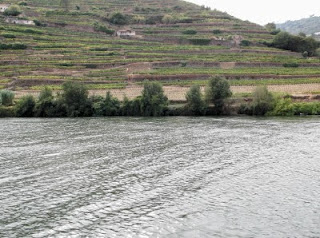People with long memories will recall a flat bottle of wine called
Mateus Rose. The label showed an ornate
manor house. Although The Casa de Mateus
exists and produces wine, it never produced Mateus Rose - just provided the
illustration for the label.
During my visit to the Valleys of the Douro
I visited this fantastic house and its beautiful gardens. The house was built in the early 18th century
and is a National Monument. It is of the
Italian Baroque style in cream with beige dressed stone trim, red tiled roofs
and ‘oriental’ style pinnacles.
The main entrance is on the first floor (second to my American readers)
and is reached by staircases from the central courtyard.
Our group was divided into two for the house tour. I don’t know what the other guide was like
but the young lady who escorted us was not only informative but also very
amusing - and enjoyed sending up the Establishment.
I’m not going to be boring by describing all of the rooms - you need to
go there to see them. There are some
pretty stupendous things to see such as the octagonal wooden ceiling in the
library with its carved central panel.
Wood is used extensively throughout the house, especially chestnut, on
ceilings, for doors and door decoration.
The rooms are, of course, filled with antiques from various countries
and include some ornate cupboards, ceramics worth a fortune, glassware and
silverware. Most of the paintings are of
the family.
I think the items that left everyone breathless are some fabulous 18th
century religious satin and taffeta garments which are heavily embroidered and,
apparently, were only used once. The
thought of the number of hours women spent working on them is mind blowing.
 Despite the number of people milling about in the gardens, because they
are divided into sections it is possible to find quiet corners. Near the house is the formal garden with
paths between the trees radiating in all directions from a central pond. Further away is the 20th century Parterre
which, because it is on a lower level, is beautiful when viewed from the
terrace.
Despite the number of people milling about in the gardens, because they
are divided into sections it is possible to find quiet corners. Near the house is the formal garden with
paths between the trees radiating in all directions from a central pond. Further away is the 20th century Parterre
which, because it is on a lower level, is beautiful when viewed from the
terrace.
The most well known part of the garden is the reflecting lake at the
front. As well as reflecting the facade
of the house it also reflects the nearby trees.
In the lake is a sleeping figure.
It is a sculpture by Joao Cutileiro and has been in the lake since 1981.
 |
| The grape treader is on lunch break. |
The Casa de Mateus does produce its own wine. As we were there during harvest it was
interesting to go into the Adega to see the vats of grapes. We were told that the grapes are still
trodden by human foot. By one man - who
was on his lunch break.
It was a lovely two to three hours and I could have happily spent the
rest of the day enjoying those gardens.
This was another of the days out during the Saga River Douro holiday.






















